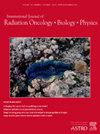DeepTuning: A Novel Deep Learning Approach for Interactive Plan Tuning and Trade-Off Exploration
IF 6.4
1区 医学
Q1 ONCOLOGY
International Journal of Radiation Oncology Biology Physics
Pub Date : 2024-10-01
DOI:10.1016/j.ijrobp.2024.07.018
引用次数: 0
Abstract
Purpose/Objective(s)
Back-and-forth plan revisions between physicians and dosimetrists occur in the planning process. They collaborate to tune plans and explore desired trade-off. To reduce back-and-forth, we proposed a new deep learning framework called DeepTuning. It can predict dose distributions with varying trade-offs from contours, so physicians can complete contours and subsequently explore trade-offs before dosimetry planning
Materials/Methods
DeepTuning can predict doses with different trade-offs by manipulating deepest layer Z (a 1 x 1 x 1024 vector). DeepTuning leverages two encoders for prior and posterior inference respectively. Prior encoder takes contours as input and extracts geometric information for conventional dose prediction, which predicts average dose with no trade-off. Posterior encoder takes both contour and dose as input and extracts ΔZ encoding the trade-off of input dose. Given a template plan from a treated patient with desired trade-off, posterior inference can extract trade-off information ΔZ. When predicting dose for a new patient with just contours, prior inference route predicts not only an average dose, but also doses with desired tradeoffs when we apply the ΔZs extracted
Results
We validated DeepTuning with a prostate dataset of 99 cases. We retrospectively optimized two VMAT plans for each case, prioritizing PTV coverage (pro-ptv) and rectum sparing (pro-oar). DeepTuning was trained / tested by 70 / 29 cases. The baseline is prior inference route that predicts fixed “average” dose distributions. Mean rectum doses are 49.5 ± 9.0 Gy, -3.1 ± 5.3% cooler than ground truth (GT) pro-ptv doses (52.0 ± 10.6 Gy) and 6.6 ± 7.9% hotter than GT pro-oar doses (44.2 ± 12.2 Gy). Then we extracted ΔZs for pro-ptv trade-off and pro-oar trade-off from the two plans of a training case. With ΔZs applied, DeepTuning can predict doses with two different trade-offs. The mean rectum doses of the pro-ptv predictions are 51.8 ± 8.5 Gy, -0.27 ± 5.1% different from GT, while pro-oar predictions are 43.8 ± 10.1 Gy, -0.6 ± 7.5% away from GT. The deviations from GT are much lower than “average” dose prediction.
Conclusion
We introduced a novel deep learning framework, DeepTuning, capable of encoding trade-offs from treated plans and predicting doses with varying trade-offs for new cases. DeepTuning empowers physicians to tune doses and explore trade-offs immediately after contouring. As the trade-off selection occurs before dosimetry planning, back-and-forth can be minimized and treatment planning workflow can be revolutionized. Furthermore, it holds promise to clinical application of auto-planning. Physicians can generate the doses distributions they desired, which serve as optimization objectives for auto-planning better than templated objectives.
DeepTuning:用于交互式计划调整和权衡探索的新型深度学习方法
目的/目标:在计划过程中,医生和剂量测定师会对计划进行来回修改。他们合作调整计划并探索所需的权衡。为了减少来回折腾,我们提出了一种名为 DeepTuning 的新深度学习框架。材料/方法DeepTuning 可以通过操作最深层 Z(1 x 1 x 1024 向量)来预测不同权衡的剂量分布。DeepTuning 利用两个编码器分别进行先验推断和后验推断。先验编码器将轮廓作为输入,并提取几何信息进行传统剂量预测,从而预测出无权衡的平均剂量。后置编码器将轮廓和剂量作为输入,并提取 ΔZ 编码输入剂量的权衡。给定已治疗病人的模板计划,并给出所需的权衡,后验推理就能提取权衡信息 ΔZ。当只用轮廓预测新患者的剂量时,先验推理不仅能预测平均剂量,还能根据提取的权衡信息ΔZ 预测所需的剂量。我们回顾性地优化了每个病例的两个 VMAT 计划,优先考虑 PTV 覆盖(pro-ptv)和直肠疏通(pro-oar)。DeepTuning 通过 70 / 29 个病例进行了训练/测试。基线是先验推理路线,预测固定的 "平均 "剂量分布。平均直肠剂量为 49.5 ± 9.0 Gy,比地面实况(GT)pro-ptv 剂量(52.0 ± 10.6 Gy)低 3.1 ± 5.3%,比 GT pro-oar 剂量(44.2 ± 12.2 Gy)高 6.6 ± 7.9%。然后,我们从一个训练病例的两个计划中提取了亲ptv权衡和亲ar权衡的ΔZ。应用 ΔZs 后,DeepTuning 可以预测两种不同权衡的剂量。pro-ptv预测的平均直肠剂量为51.8 ± 8.5 Gy,与GT相差-0.27 ± 5.1%,而pro-oar预测的平均直肠剂量为43.8 ± 10.1 Gy,与GT相差-0.6 ± 7.5%。结论我们引入了一种新型深度学习框架--DeepTuning,它能够对治疗计划中的权衡进行编码,并根据新病例的不同权衡预测剂量。DeepTuning 使医生能够在轮廓塑造后立即调整剂量和探索权衡。由于权衡选择发生在剂量测定规划之前,因此可以最大限度地减少来回折腾,彻底改变治疗规划工作流程。此外,它还为自动规划的临床应用带来了希望。医生可以生成他们所需的剂量分布,作为自动规划的优化目标,其效果优于模板目标。
本文章由计算机程序翻译,如有差异,请以英文原文为准。
求助全文
约1分钟内获得全文
求助全文
来源期刊
CiteScore
11.00
自引率
7.10%
发文量
2538
审稿时长
6.6 weeks
期刊介绍:
International Journal of Radiation Oncology • Biology • Physics (IJROBP), known in the field as the Red Journal, publishes original laboratory and clinical investigations related to radiation oncology, radiation biology, medical physics, and both education and health policy as it relates to the field.
This journal has a particular interest in original contributions of the following types: prospective clinical trials, outcomes research, and large database interrogation. In addition, it seeks reports of high-impact innovations in single or combined modality treatment, tumor sensitization, normal tissue protection (including both precision avoidance and pharmacologic means), brachytherapy, particle irradiation, and cancer imaging. Technical advances related to dosimetry and conformal radiation treatment planning are of interest, as are basic science studies investigating tumor physiology and the molecular biology underlying cancer and normal tissue radiation response.

 求助内容:
求助内容: 应助结果提醒方式:
应助结果提醒方式:


